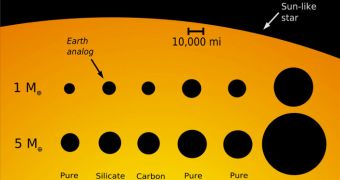According to the conclusions of a new scientific study, it would appear that Sun-like stars around our galaxy harbor alien Earths very often. It is estimated that between 1-in-37 and 1-in-70 of them contain such extrasolar planets in their orbits.
Yellow dwarf stars may therefore be the most suitable type of cosmic fireball to allow for the development of a planet similar to our own. The reason why astronomers are looking for such objects is that they have the highest chances of meeting some of the conditions required by life.
The line of thought governing the search is simple – find the elements that make Earth capable of supporting life, and then search them elsewhere in the Universe. There are literally thousands of such conditions, but experts are currently looking for the most important ones.
These include the location of an exoplanet in regards to its parent star's habitable zone, its size and chemical composition, the type of atmosphere it has, the amount of gravity things on the surface are subjected to, the presence of a liquid core, and many more.
Based on the new calculations, it may be that up to 2 billion alien Earths may exist around the Milky Way. The galaxy is estimated to be 100,000 light-years in diameter, and to contain anywhere between 100 and 400 billion stars.
The conclusions in the new study were drawn based on data sent back by the NASA Kepler planet-hunting telescope, which recently revealed the existence of 1,200 exoplanetary candidates.
The proportions of stars analyzed for the research was compared to the numbers and types of planets discovered around each of them, and a chart of probabilities was produced based on that.
“This means there are a lot of Earth analogs out there. With that large a number, there's a good chance life and maybe even intelligent life might exist on some of those planets,” says Joseph Catanzarite, Space reports
“And that's just our galaxy alone – there are 50 billion other galaxies,” adds the researcher, who is an astronomer at the NASA Jet Propulsion Laboratory (JPL), in Pasadena, California.
The new investigation also determined that red dwarf stars may contain Earth-like exoplanets as well. The only difference in those star systems would be that the space rocks would need to be a lot closer to the surface of their parent stars, due to the lower amounts of heat they emit.
“I'd expect to hear one day about habitable Earth analogs around these stars,” Catanzarite explains. He and expert Michael Shao published a paper detailing their analysis in the March 8 online issue of the Astrophysical Journal.

 14 DAY TRIAL //
14 DAY TRIAL //